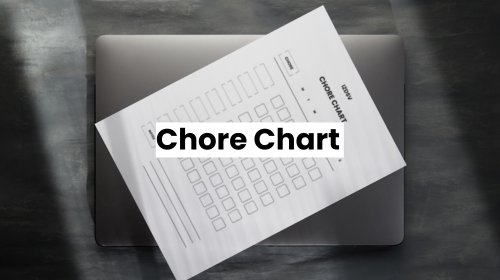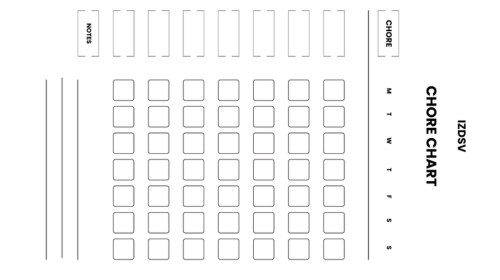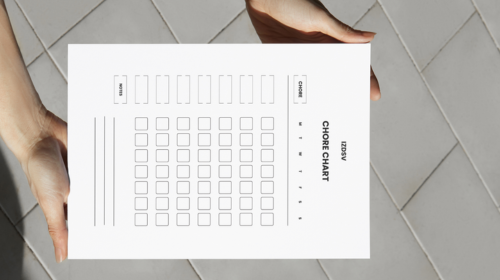Color-Coded vs. Regular Chore Charts: Which Chore Chart System is Best for Your Family?
Understanding the Basics of Chore Charts
Chore charts are fundamental organizational tools that help families manage household responsibilities systematically and fairly. They provide structure to what can otherwise be chaotic household management by creating clear expectations and accountability for all family members.
- Establishes household routine – Creates predictable patterns for when and how tasks get completed
- Teaches life skills early – Introduces children to essential daily living capabilities they’ll need as adults
- Reduces parental stress – Distributes household workload beyond just parents or primary caregivers
- Creates family teamwork – Encourages everyone to contribute to maintaining their shared living space
- Builds character traits – Develops responsibility, accountability, and work ethic in children and teens
- Provides structure for chaos – Transforms overwhelming household management into manageable, organized systems
- Establishes clear expectations – Everyone knows what’s expected of them and when tasks should be completed
- Creates learning opportunities – Teaches time management, prioritization, and follow-through skills
What is a Chore Chart?
A chore chart is a visual organizational tool that lists household tasks and assigns them to specific family members, typically displayed on a board, paper, or digital format. It serves as a systematic way to distribute responsibilities and track completion of various household duties across different time periods.
- Visual tracking system – Usually displayed as a grid or list showing tasks, assigned people, and completion status
- Task assignment tool – Clearly designates who is responsible for specific household duties
- Progress monitoring method – Allows families to see what’s been completed and what still needs attention
- Accountability mechanism – Creates transparency about everyone’s contributions to household maintenance
- Scheduling framework – Organizes when tasks should be completed (daily, weekly, monthly)
- Communication device – Reduces confusion and arguments about who should do what chores
The Purpose of a Chore Chart System
A chore chart system aims to create structure and fairness in household management while teaching responsibility and life skills to all family members. It transforms chaotic household management into an organized, predictable routine that reduces stress and builds important character traits.
- Distribute workload fairly – Ensures household tasks are shared equitably among family members
- Teach responsibility – Helps children and teens develop accountability for their living environment
- Build life skills – Provides practical training in essential daily living capabilities
- Reduce parental burden – Shifts some household management responsibility to other family members
- Eliminate confusion – Clearly defines expectations so everyone knows their role
- Create routine structure – Establishes predictable patterns that make household management smoother
- Foster teamwork – Encourages family members to work together toward common household goals
- Track progress – Provides visual feedback on task completion and family contributions
- Prepare for independence – Gives children experience managing responsibilities they’ll need as adults
- Reduce conflicts – Minimizes arguments about unfair workload distribution or forgotten tasks
Exploring Color-Coded Chore Charts
Color-coded chore charts represent an evolution from traditional text-based systems, utilizing visual color associations to make household task management more intuitive and engaging for families. This approach transforms mundane chore tracking into a more visually appealing and functionally efficient system that works across different ages and learning styles.
- Visual enhancement of traditional systems – Takes basic chore charts and adds color elements to improve functionality and appeal
- Universal accessibility approach – Works for family members regardless of reading level, age, or learning preferences
- Systematic color organization – Uses consistent color schemes to create logical, easy-to-follow household management systems
- Multi-generational effectiveness – Appeals to both children who respond to visual stimuli and adults who appreciate quick reference systems
- Customizable family solutions – Can be adapted to fit different family sizes, ages, and household management styles
- Integration with reward systems – Colors can connect to motivation and reward tracking for enhanced engagement
- Modern organizational tool – Represents current thinking about making household management more efficient and less stressful
- Bridge between analog and digital – Works equally well on physical boards or digital apps and platforms
- Psychological engagement factor – Leverages color psychology to make task completion more satisfying and motivating
- Scalable complexity levels – Can start simple for young families and grow more sophisticated as children develop
Benefits of Color-Coded Chore Charts
Color-coded chore charts enhance visual organization by making it instantly clear who is responsible for which tasks through assigned colors for each family member. This system reduces confusion and creates a more engaging, visually appealing way to track household responsibilities that appeals especially to visual learners.
- Instant visual recognition – Family members can quickly identify their tasks without reading names or detailed instructions
- Reduces reading barriers – Particularly helpful for young children who may not yet read fluently or have learning differences
- Creates personal ownership – Each person develops a connection to “their” color, fostering responsibility and pride
- Eliminates confusion – No need to decipher handwriting or wonder whose task is whose
- Appeals to visual learners – Makes the system more accessible for people who process information better through visual cues
- Increases engagement – Colorful charts are more attractive and motivating than plain text versions
- Speeds up the checking process – Parents and family members can assess completion status at a glance
- Accommodates different ages – Works for pre-readers, struggling readers, and visual processors simultaneously
- Creates systematic organization – Establishes clear visual patterns that become automatic over time
- Enhances motivation – The visual appeal and personal color assignment can make chores feel less burdensome
How Color-Coded Chore Systems Work
Color-coded chore systems assign each family member a specific color that represents them across all their assigned tasks on the chart. The system typically uses colored markers, stickers, magnets, or backgrounds to indicate both task assignment and completion status throughout the tracking period.
- Individual color assignment – Each family member gets their own designated color (red for Mom, blue for Dad, green for eldest child, etc.)
- Task identification – All tasks assigned to one person appear in their designated color on the chart
- Completion tracking – Family members use their color to mark tasks as done (colored stickers, checkmarks, or moved magnets)
- Visual status updates – The chart shows at a glance which tasks are complete and which still need attention
- Rotating assignment options – Colors can rotate weekly or monthly to ensure fair distribution of preferred/less preferred tasks
- Age-appropriate adaptation – Younger children might use simple colored dots while older kids handle more complex color-coding systems
- Multiple coding layers – Some systems use different shades or patterns within colors to indicate task difficulty or frequency
- Digital integration – Apps and digital charts can automatically color-code assignments and send reminders in each person’s color
- Reward system integration – Completed tasks in each color can contribute to individualized reward tracking
- Flexibility for changes – Easy to reassign tasks by simply changing colors rather than rewriting entire sections
Examining Regular Chore Charts
Regular chore charts are the traditional, straightforward approach to household task management that rely primarily on text-based lists and basic checkboxes or tracking methods. These systems focus on clear task assignment and completion tracking without additional visual enhancements, making them simple to create and maintain while still providing effective organization for family responsibilities.
- Simple text-based organization – Uses straightforward lists, names, and task descriptions without complex visual elements
- Easy to create and modify – Can be made with basic materials like paper, whiteboards, or simple digital tools
- Universal readability – Works for anyone who can read, regardless of visual learning preferences or color perception
- Cost-effective solution – Requires minimal materials and no special supplies or technologies
- Flexible format options – Can be implemented on paper, whiteboards, bulletin boards, or basic digital platforms
- Clear accountability structure – Focuses on task completion and responsibility without visual distractions
- Timeless approach – Proven method that has worked for families across generations and cultures
- Minimal maintenance required – Easy to update, erase, and restart without complex setup procedures
- Professional appearance – Clean, organized look that works well in any household setting
- Focus on content over aesthetics – Emphasizes the actual tasks and responsibilities rather than visual appeal
Advantages of Regular Chore Charts
Regular chore charts offer simplicity and reliability as their primary strengths, making them accessible to all family members regardless of age or learning style. They eliminate the complexity of color systems while maintaining clear organization and accountability that families need for effective household management.
- Straightforward implementation – No need to coordinate colors, purchase special materials, or learn complex systems
- Clear text communication – Tasks and expectations are spelled out explicitly, reducing misinterpretation
- Easy modification – Simple to add, remove, or change tasks without affecting the entire system design
- Works for all ages – Effective for families with teenagers and adults who don’t need visual color cues
- Cost-effective maintenance – Uses common household supplies like paper, pens, and basic boards
- Professional appearance – Clean, organized look that works well in formal household settings
- No color coordination needed – Eliminates confusion about color assignments or running out of specific colored supplies
- Focus on task completion – Emphasizes getting work done rather than managing visual systems
- Universal accessibility – Works equally well for family members with color blindness or visual processing differences
- Proven effectiveness – Time-tested approach that has successfully organized households for decades
How to Implement a Regular Chore Chart
Implementing a regular chore chart begins with listing all necessary household tasks and then systematically assigning them to family members based on age, ability, and fairness. The key is creating a clear, readable format that everyone can understand and use consistently without confusion or complexity.
- List all household tasks – Write down everything that needs to be done daily, weekly, and monthly throughout your home
- Assess family member capabilities – Consider age, physical ability, schedule, and skill level when making assignments
- Create fair task distribution – Balance workload so no single person carries an unfair burden of responsibilities
- Choose your format – Decide between paper charts, whiteboards, bulletin boards, or simple digital spreadsheets
- Design a clear layout – Organize information in columns showing tasks, assigned person, frequency, and completion tracking
- Establish completion method – Set up checkboxes, signature lines, or simple marking systems to track finished tasks
- Set clear expectations – Define what “complete” means for each task and when tasks should be finished
- Create visible placement – Position the chart where all family members will see it regularly throughout their day
- Establish review schedule – Plan regular family meetings to assess progress and make necessary adjustments
- Start simple and adjust – Begin with basic tasks and add complexity as the system becomes routine for everyone
Comparing Color-Coded and Regular Chore Charts
Color-coded and regular chore charts each offer distinct advantages depending on your family’s needs, with color-coded systems providing visual appeal and instant recognition while regular charts offer simplicity and universal accessibility. The choice between these approaches often depends on family composition, learning styles, and the level of complexity parents want to manage in their household organization system.
- Visual appeal differences – Color-coded charts are more engaging and attractive, while regular charts maintain a professional, clean appearance
- Implementation complexity – Regular charts are simpler to create and maintain, while color-coded systems require coordination of supplies and assignments
- Age appropriateness – Color-coded works better for younger children, while regular charts suit older kids and adults effectively
- Learning style accommodation – Color systems benefit visual learners while text-based charts serve reading-focused family members
- Cost considerations – Regular charts use basic supplies, while color-coded systems may require ongoing colored materials
- Maintenance requirements – Text-based charts are easier to modify, while color systems need consistent supply management
- Accessibility factors – Regular charts work for everyone, while color-coded systems may challenge those with color vision differences
- Engagement levels – Colorful charts typically motivate younger children more, while older family members may prefer straightforward approaches
- Flexibility in changes – Regular charts allow quick modifications while color systems require coordinated updates
- Long-term sustainability – Text-based systems often prove more sustainable as children mature and preferences change
Effectiveness for Different Age Groups
Different age groups respond distinctly to chore chart systems, with younger children generally benefiting from visual, colorful approaches while teenagers and adults often prefer straightforward, text-based organization. Understanding these age-related preferences helps families choose the most effective system for their household composition and ensures better compliance across all family members.
- Ages 3-6 (Preschoolers) – Respond best to color-coded systems with pictures, simple tasks, and immediate visual feedback
- Ages 7-10 (Early Elementary) – Benefit from color systems but can handle more complex regular charts with clear task descriptions
- Ages 11-13 (Middle School) – Often prefer regular charts that treat them more maturely while still appreciating some visual organization
- Ages 14-17 (High School) – Generally respond better to straightforward, adult-like regular charts without childish visual elements
- Adults – Typically prefer efficient, professional-looking regular charts that focus on task completion over visual appeal
- Mixed-age families – May need hybrid approaches or separate systems to accommodate different developmental needs effectively
- Special needs considerations – Visual learners and those with reading challenges benefit from color-coded systems regardless of age
- Developmental readiness – Chart complexity should match cognitive abilities rather than strict chronological age guidelines
- Transition periods – Families may need to evolve from color-coded to regular systems as children mature
- Individual preferences – Some children prefer adult-like charts, while some adults enjoy colorful, engaging visual systems
Engagement of Kids for Their Chores
Children’s engagement with chore systems varies significantly based on the presentation method, with color-coded charts typically generating more initial excitement and sustained interest among younger children. However, the key to long-term engagement lies in matching the chart style to individual personality, learning preferences, and developmental stage rather than assuming one approach works for all children.
- Visual stimulation impact – Colorful charts capture attention and create positive associations with household responsibilities
- Ownership through personalization – Assigned colors help children feel the chart and tasks belong specifically to them
- Gamification elements – Color systems can easily incorporate game-like features, rewards, and progress tracking that motivate participation
- Age-appropriate engagement – Younger children respond to visual excitement, while older kids prefer respect for their maturity
- Immediate feedback satisfaction – Color-coded completion markers provide instant visual gratification that reinforces positive behavior
- Social comparison factors – Children can easily see how their colored progress compares to their siblings’ achievements
- Novelty and interest maintenance – Colorful systems may maintain interest longer than plain text approaches for visually-oriented children
- Individual learning style matching – Visual learners engage more with color-coded systems, while text-focused children prefer regular charts
- Reward system integration – Both chart types can connect to allowances, privileges, or family rewards, but colors make tracking more engaging
- Long-term motivation sustainability – Initial excitement from any new system typically fades, making consistency and fairness more important than chart type
Choosing the Best Chore Chart for Kids
Selecting the most effective chore chart for children requires careful consideration of your family’s unique dynamics, including ages, personalities, learning styles, and household routines. The best chore chart is one that matches your children’s developmental needs while being sustainable for parents to maintain consistently over time.
- Child’s age and developmental stage – Consider reading ability, attention span, and cognitive capacity for understanding responsibility
- Learning style preferences – Assess whether your child responds better to visual, auditory, or kinesthetic learning approaches
- Family size and dynamics – Factor in number of children, age gaps, and sibling relationships that might affect chart design
- Household routine complexity – Match chart sophistication to the number and variety of tasks your family needs to track
- Parent maintenance capacity – Choose systems that fit your available time and energy for updating and managing the chart
- Budget considerations – Evaluate costs of materials, printing, and ongoing supplies needed for different chart types
- Physical space availability – Consider where the chart will be displayed and how much wall or counter space you have
- Technology comfort level – Decide between digital apps, printable options, or handmade charts based on family tech preferences
- Long-term sustainability – Select approaches that can grow and adapt as children mature and family needs change
- Motivational factors – Identify what drives your specific children to complete tasks and engage with responsibility systems
Factors to Consider When Selecting a Chore Chart
The effectiveness of any chore chart depends on matching the system to your family’s specific needs, personalities, and lifestyle patterns. Key considerations include developmental appropriateness, practical maintenance requirements, and the ability to sustain engagement over time while teaching genuine responsibility skills.
- Child’s current responsibility level – Start with charts that match existing capabilities rather than overwhelming with complexity
- Reading and comprehension abilities – Ensure task descriptions and chart format are appropriate for literacy levels
- Attention span and focus capacity – Choose chart complexity that matches how long children can concentrate on the organization
- Motivation triggers – Identify what encourages your child (visual rewards, checking boxes, earning privileges, helping family)
- Consistency requirements – Select systems you can realistically maintain without becoming another source of family stress
- Flexibility for changes – Choose formats that allow easy modification as children grow and household needs evolve
- Integration with existing routines – Pick charts that fit naturally into your current family schedules and habits
- Sibling considerations – Account for fairness, competition, and cooperation dynamics between multiple children
- Special needs accommodations – Adapt chart design for any learning differences, physical limitations, or processing challenges
- Cultural and family values – Ensure the chart approach aligns with your beliefs about childhood, responsibility, and family contribution
Printable Chore Charts: A Convenient Option
Printable chore charts offer an excellent middle ground between completely handmade systems and expensive commercial products, providing a professional appearance with customizable flexibility. These ready-made templates can be downloaded, printed at home, and modified to fit specific family needs while maintaining an attractive, organized presentation.
- Cost-effective solution – One-time download or free templates eliminate ongoing expenses while providing professional designs
- Immediate availability – Can be printed and implemented the same day without waiting for shipping or store visits
- Customization flexibility – Many templates allow editing of tasks, names, and timeframes before printing
- Professional appearance – Well-designed templates create attractive, organized charts without artistic skills required
- Variety of styles – Available in color-coded, regular, themed, and age-specific designs to match family preferences
- Easy replacement – When charts get worn or need updates, simply print fresh copies without recreating entire systems
- Seasonal adaptations – Many sites offer themed charts for holidays, school years, or seasonal task variations
- Size options – Available in different formats from small personal charts to large family organization boards
- Digital integration – Some printable charts connect to apps or online tracking for hybrid organizational approaches
- Trial flexibility – Easy to test different styles and formats without significant investment to find what works best




